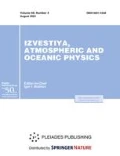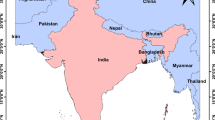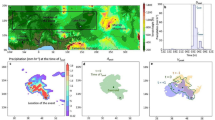Abstract
The possibility for approximate basic statistical characteristics of atmospheric models using periodic trajectories (closed solutions of equations of dynamics) is considered. The possibility of this approximation is based on ideas of the theory of dynamical systems which states that, in some important particular cases (e.g., for hyperbolic systems), the periodic trajectories define the invariant system measure related to a notion of the system climate. It is shown that this approximation also is possible in the case of the atmospheric models under consideration. Moreover, the principal modes of circulation variability are implemented as clusters of periodic orbits oriented along the leading eigenvectors of dynamical operators of models linearized with respect to their mean states. The analysis of observational data shows that probably the same conclusion could also be made for the real atmospheric circulation.






Similar content being viewed by others
REFERENCES
C. G. Rossby et al., “Relation between variations in the intensity of the zonal circulation of the atmosphere and the displacements of the semi-permanent centers of action,” J. Mar. Res. 2, 38–55 (1939).
J. G. Charney, “The dynamics of long waves in a baroclinic westerly current,” J. Meteorol. 4, 135–162 (1947).
E. T. Eady, “Long waves and cyclone waves,” Tellus 1, 33–52 (1949).
A. J. Simmons and B. J. Hoskins, “Baroclinic instability on the sphere: Normal modes of the primitive and quasigeostrophic equations,” J. Atmos. Sci. 33, 1454–1477 (1976).
J. S. Frederiksen, “A unified three-dimensional instability theory of the onset of blocking and cyclogenesis,” J. Atmos. Sci. 39, 969–982 (1982).
V. P. Dymnikov, “On the connection between the orthogonal components of meteoelement fields to the eige-nfunctions of the dynamic operators,” Izv., Acad. Sci., USSR, Atmos. Oceanic Phys. (Engl. Transl.) 24 (7), 675–683 (1988).
K. Hasselmann, “PIPs and POPs: The reduction of complex dynamical systems using principal interaction and oscillation patterns,” J. Geophys. Res. 93, 11015–11021 (1988).
H. H. von Storch, T. Bruns, I. Fischer-Bruns, and K. Hasselmann, “Principal oscillation pattern analysis of the 30- to 60-day oscillation in general circulation model equatorial troposphere,” J. Geophys. Res. 93, 11022–11036 (1988).
H. H. von Storch, U. Weese, and J. S. Xu, “Simultaneous analysis of space-time variability: Principal oscillation patterns and principal interaction patterns with applications to the Southern Oscillation,” Z. Meteorol. 40, 99–103 (1990).
J.-S. Xu, “Predicting the state of the Southern Oscillation using principal oscillation pattern analysis,” J. Clim. 3, 1316–1329 (1990).
R. Schnur, G. Schmitz, N. Grieger, and H. von Storch, “Normal modes of the atmosphere as estimated by principal oscillation patterns and derived from quasigeostrophic theory,” J. Atmos. Sci. 50, 2386–2400 (1993).
J. G. Charney and J. G. DeVore, “Multiple flow equilibria in the atmosphere and blocking,” J. Atmos. Sci. 36, 1205–1216 (1979).
B. Legras and M. Ghil, “Persistent anomalies, blocking and variations in atmospheric predictability,” J. Atmos. Sci. 42, 433–471 (1985).
K. Mo and M. Ghil, “Cluster analysis of multiple planetary flow regimes,” J. Geophys. Res.: Atmos. 93, 10927–10952 (1988).
V. P. Dymnikov and E. V. Kazantsev, “Structure of an attractor generated by the system of equations of a barotropic atmosphere,” Izv. Akad. Nauk, Fiz. Atm. Okeana 29, 581–595 (1993).
K. Vautard, K. Mo, and M. Ghil, “Statistical significance test for transition matrices of atmospheric Markov chains,” J. Atmos. Sci. 47, 1926–1931 (1990).
M. Kimoto and M. Ghil, “Multiple flow regimes in the Northern Hemisphere winter. Part II: Sectorial regimes and preferred transitions,” J. Atmos. Sci. 50, 2645–2673 (1993).
D. Kondrashov, K. Ide, and M. Ghil, “Weather regimes and preferred transition paths in a three-level quasigeostrophic model,” J. Atmos. Sci. 61, 568–587 (2004).
A. J. Majda, C. L. Franzke, A. Fischer, and D. T. Crommelin, “Distinct metastable atmospheric regimes despite nearly Gaussian statistics: A paradigm model,” Proc. Natl. Acad. Sci. U. S. A. 103, 8309–8314 (2006).
C. Franzke, D. Crommelin, A. Fischer, and A. J. Majda, “A hidden Markov model perspective on regimes and metastability in atmospheric flows,” J. Clim. 21, 1740–1757 (2008).
R. Bowen, “Periodic points and measures for axiom A diffeomorphisms,” Trans. Am. Math. Soc. 154, 377–397 (1971).
R. Bowen, “Periodic orbits for hyperbolic flows,” Am. J. Math. 94, 1–30 (1972).
D. Auerbach, P. Cvitanovic, J. -P. Eckmann, G. Gunaratne, and I. Procaccia, “Exploring chaotic motion through periodic orbits,” Phys. Rev. Lett. 58, 2387–2389 (1987).
D. Ruelle, “Smooth dynamics and new theoretical ideas in nonequilibrium statistical mechanics,” J. Stat. Phys. 95, 393–468 (1999).
V. Dymnikov and A. Filatov, Mathematics of Climate Modelling (Birkhauser, Boston, 1997).
G. Gallavotti, “Chaotic dynamics, fluctuations, nonequilibrium ensembles,” Chaos 8 (2), 384–392 (1998).
E. Kazantsev, “Unstable periodic orbits and attractor of the barotropic ocean model,” Nonlinear Proc. Geophys. 5, 281–300 (1998).
F. M. Selten and G. Branstator, “Preferred regime transition routes and evidence for an unstable periodic orbit in a baroclinic model,” J. Atmos. Sci. 61, 2267–2282 (2004).
A. Gritsun, “Unstable periodic trajectories of a barotropic model of the atmosphere,” Russ. J. Num. Anal. Math. Modell. 23 (4), 345–367 (2008).
A. S. Gritsun, “Statistical characteristics of barotropic atmospheric system and its unstable periodic solutions,” Dokl. Earth Sci. 435, 1688–1691 (2010).
A. Gritsun, “Connection of periodic orbits and variability patterns of circulation for the barotropic model of atmospheric dynamics,” Dokl. Earth Sci. 438, 636–640 (2011).
A. Gritsun, “Statistical characteristics, circulation regimes and unstable periodic orbits of a barotropic atmospheric model,” Philos. Trans. R. Soc., A 371, 20120336 (2013).
J. Marshall and F. Molteni, “Toward a dynamical understanding of planetary scale flow regimes,” J. Atmos. Sci. 50, 1792–1818 (1993).
G. P. Kurbatkin, V. N. Sinyaev, and A. G. Yantsen, “Spectral model of a long-term prognosis with average climatic restrictions,” Izv., Acad. Sci., USSR, Atmos. Oceanic Phys. 9 (11), 3–8 (1973).
C. Franzke, A. Majda, and E. Vanden-Eijnden, “Low-order stochastic mode reduction for a realistic barotropic model climate,” J. Atmos. Sci. 62, 1722–1745 (2005).
V. P. Dymnikov and A. S. Gritsun, “Barotropic instability and the structure of low-frequency variability of circulation generated by a two-layer baroclinic atmosphere model,” Izv. Akad. Nauk, Fiz. Atmos. Okeana 32 (5), 535–538 (1996).
H. von Storch and F. Zwiers, Statistical Analysis in Climate Research (Cambridge University Press, Cambridge, 1999).
W. H. Press, S. A. Teukolsky, W. T. Vetterling, B. P. Flannery, and M. Metcalf, Numerical Recipes in Fortran 90 (Cambridge University Press, Cambridge, 1986).
Funding
This work was supported by the Moscow Center of Fundamental and Applied Mathematics (development of methods of the search for periodic trajectories) and the Russian Foundation for Basic Research, project no. 17-55-10012 KO_a (analysis of models).
Author information
Authors and Affiliations
Corresponding author
Additional information
Translated by M. Samokhina
Rights and permissions
About this article
Cite this article
Gritsun, A.S. Variability of Extra Tropical Atmospheric Circulation and Periodic Trajectories in Simplified Models of Atmospheric Dynamics. Izv. Atmos. Ocean. Phys. 56, 229–240 (2020). https://doi.org/10.1134/S0001433820030093
Received:
Revised:
Accepted:
Published:
Issue Date:
DOI: https://doi.org/10.1134/S0001433820030093




